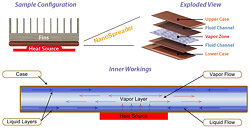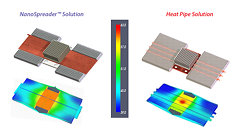Tuesday, October 21st 2008

AMD and Celsia Technologies Collaborate on a New GPU Cooling Solution
AMD and Celsia Technologies announced today a strategic partnership in which Celsia may become the cooling system manufacturer for ATI's next generation video cards. For now both companies are working on a vapor chamber based cooling solution for high end graphics cards and that's all we have. The cooling module includes Celsia's patented NanoSpreader that "significantly outperforms competing heat pipe based solutions." A NanoSpreader is a patented copper encased two-phase vapor chamber into which pure water is vacuum sealed. The liquid is absorbed by a copper-mesh wick and passed as vapor through a micro-perforated copper sheet where it cools and returns as liquid to the wick. NanoSpreaders are half the weight of solid copper, and yet they perform 14% better than heat pipes.
"Working with AMD, we were able to meet all of the design criteria for a new GPU cooler. Namely, it had to be lighter, perform better and be lower cost than the current heat pipe based design," said Joe Formichelli, Celsia's CEO. "Unlike thermal modules using heat pipes, our two-phase NanoSpreader comes in direct contact with the heat source whereby removing costly, heavy base plates."
As part of AMD's technology development project, Celsia has been invited to present at the 2008 AMD Technical Forum and Exposition tomorrow in Taiwan. Additionally, a short video explaining Celsia's NanoSpreader vapor chamber technology will be shown as part of the conference's opening presentation.
Source:
Celsia Technologies
"Working with AMD, we were able to meet all of the design criteria for a new GPU cooler. Namely, it had to be lighter, perform better and be lower cost than the current heat pipe based design," said Joe Formichelli, Celsia's CEO. "Unlike thermal modules using heat pipes, our two-phase NanoSpreader comes in direct contact with the heat source whereby removing costly, heavy base plates."
As part of AMD's technology development project, Celsia has been invited to present at the 2008 AMD Technical Forum and Exposition tomorrow in Taiwan. Additionally, a short video explaining Celsia's NanoSpreader vapor chamber technology will be shown as part of the conference's opening presentation.


16 Comments on AMD and Celsia Technologies Collaborate on a New GPU Cooling Solution
then if that true, maybe next generation gpu from AMD will break 1 Ghz barier. ah that was overclocker dream.
maybe 4Ghz denebFX can be posible with that technology
Vapor chambers are nothing new, but sapphire have proved their effectiveness. They are basically a very wide version of a heatpipe, and they work in a similar manner. Its just that in this case the vapor chamber can be utilised better. From what I understand they are doing like HDT; the core of the GPU will be touching the vapor chamber.
Mem cooling will be good as well if they go ahead with this. Hmm... single slot 4850/4870/new 5xxx cards that run cool and quiet anyone? :D
Now I'm not saying this will fail, but they seem to be following the same path and I don't think Vapochill did a bad work, so if they want to improve uppon that technology they will have to excell IMHO, and that's not easy.
On the other hand it could be worth it if only for the weight reduction.
but yeah, anything that improves on the X2 stock cooler = win win situation, I'd pay £15~ more for that.
Also, I'm not familiar with the Vapochill tech you were talking about but from what I'm seeing after a quick google search of it I'm not sure why you would compare it to that instead of the sapphire cards which seem to work on the exact same premise. (see www.hardwarecanucks.com/forum/hardware-canucks-reviews/7245-sapphire-hd3870-512mb-toxic-edition-review-6.html)
I'd agree it's best to see it in action before putting too much stock into it but looking quickly at that review it seems pretty promising (images.hardwarecanucks.com/image/skymtl/GPU/SAPPHIRE-TOXIC/TOXIC-44.jpg)
Of course we have to wait and see what happens, but I have my doubts on this, because the known precedents are not very promising.